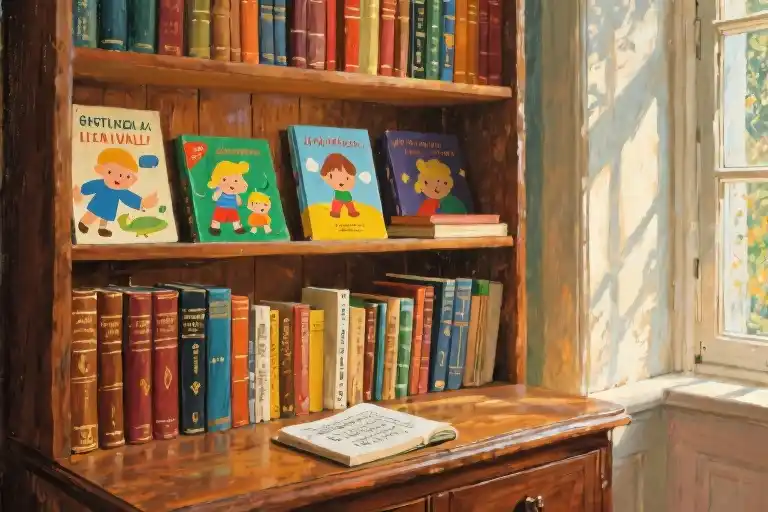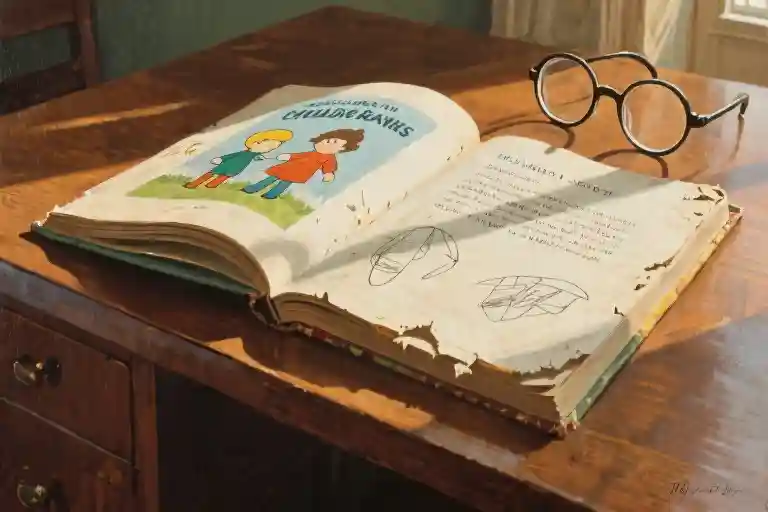The worn inscription on the Newbery Medal—’For the most distinguished contribution to American literature for children’—still faintly echoes its original 18th-century purpose: ‘for the delight and improvement of children.’ This duality captures the eternal tension in children’s literature, as visible today as it was in 1740 when young minds memorized Bible verses, just as modern children now dissect graphic novel Easter eggs in Dav Pilkey’s Dog Man.
Between these two historical bookends lies our central question: Must educational value and entertainment exist in opposition? The answer begins with a London bookseller’s radical 18th-century innovation—John Newbery’s decision to package moral lessons with marbles. That simple act of bundling a Latin primer with playthings in 1744 became the first conscious balancing act in children’s publishing.
Modern creators face amplified versions of Newbery’s challenge. Industry veterans recognize the unspoken pressure—what many call the ‘preach’n’teach’ mandate—to deliver moral instruction disguised as story. Yet sales charts show equal demand for pure escapism, creating a dangerous pendulum swing between didacticism and frivolity. The most telling evidence? Library circulation statistics reveal how quickly extreme examples from either camp—stiff morality tales or plotless comedies—disappear from heavy rotation.
Three centuries of evolution have brought us to this crossroads. Early American children’s literature, heavily influenced by Puritan values, functioned as moral vaccination—stories like The New England Primer (1683) used alphabet verses (‘A—In Adam’s fall / We sinned all’) to instill doctrinal fear. Newbery’s breakthrough wasn’t abandoning education, but rather understanding that joy could be the delivery mechanism. His A Little Pretty Pocket-Book (1744) included a ball or pincushion because he recognized what modern neuroscience confirms: play scaffolds learning.
That revolutionary balance—now memorialized in the Newbery Medal’s tarnished inscription—holds the secret to timeless children’s literature. The medal’s physical wear mirrors how we’ve eroded Newbery’s original vision, with contemporary publishing often forcing creators to choose between meaning and marketability. Yet when we examine perennial classroom favorites—from Charlotte’s Web to Wonder—they share DNA with Newbery’s pioneering approach: wrapping life’s harder lessons in wonder, much like the marble that once rolled alongside a Latin lesson.
As we turn the page from this introduction, keep that image in mind—the textbook and the toy sharing the same shelf. The subsequent chapters will map how we lost that equilibrium, why it matters, and most importantly, how today’s creators can reclaim it.
From Moral Pamphlets to Playful Commodities: Three Centuries of Children’s Literature Evolution
The leather-bound volumes of 18th-century children’s literature would hardly be recognized as such by today’s young readers. These early works, often titled Divine Songs or Spiritual Milk for Babes, contained more catechism than characters, their pages filled with stern directives about proper behavior and eternal damnation. A typical 1742 edition of The Child’s Guide to Virtue opens with this cheerful greeting: “Remember now thy Creator in the days of thy youth, lest thou die in thy sins and be cast into everlasting fire.”
The Puritan Legacy: Saving Souls Through Stories
Early children’s literature served as theological survival guides, reflecting Puritan beliefs that:
- Children were born sinful and needed moral correction
- Reading materials should primarily prepare souls for salvation
- Entertainment without instruction was dangerous indulgence
Surviving copies show heavy wear on pages about hellfire warnings, suggesting these sections received particular emphasis during reading sessions. The 1767 Boston edition of A Token for Children even included engraved illustrations of dying children as cautionary tales.
The Newbery Revolution: Marbles with Morals
Everything changed when London publisher John Newbery (whose name now graces America’s most prestigious children’s book award) began selling A Little Pretty Pocket-Book in 1744. His innovation wasn’t just the content – though replacing damnation with alphabet rhymes marked progress – but his revolutionary marketing approach:
- Product Bundling: Each book came with a free gift (a ball for boys, a pincushion for girls)
- Child-Centric Design: Small trim sizes perfect for little hands
- Positive Reinforcement: Included “moral hieroglyphics” where good deeds earned pins to decorate the gifts
Newbery’s 1758 advertisement in The London Chronicle promised “instruction with delight,” establishing the dual mission that still challenges children’s literature today. His shop at St. Paul’s Churchyard became the first known commercial space dedicated to children’s books.
The Disney Effect: When Entertainment Took Center Stage
Fast-forward to 20th-century America, where mass media transformed children’s publishing:
| Era | Key Development | Market Impact |
|---|---|---|
| 1920-1940 | Radio programs create child audiences | Publishers seek livelier content |
| 1950-1970 | Television demands faster pacing | Picture books adopt cinematic techniques |
| 1980-2000 | Franchise characters dominate | Merchandising revenue surpasses book sales |
By 1999, a Publishers Weekly study showed 72% of children’s bestsellers were media tie-ins, compared to just 11% in 1969. This commercial shift brought vibrant new formats but also intensified the tension between artistic merit and market demands.
The Enduring Dilemma
As we examine a 1744 Newbery advertisement side-by-side with a modern Scholastic book club flyer, the core challenge remains strikingly similar: how to honor children’s need for joy while acknowledging adults’ desire for substance. That London shopkeeper’s genius wasn’t in choosing between education and entertainment, but in recognizing they could share the same binding – just as today’s best creators weave meaning into stories children genuinely choose to read.
Next: [The Seesaw Effect: Modern Publishing’s Polarizing Pressures]
The Seesaw Dilemma: When Children’s Books Fall into Extremes
Walk into any children’s section today and you’ll witness a curious divide. On one shelf, brightly colored covers promise endless laughter with toilet humor and slapstick adventures. On another, somber-toned books proclaim Important Life Lessons in bold serif fonts. This polarization between pure entertainment and heavy-handed instruction represents one of children’s literature’s most persistent challenges.
Case Study: The Modern Backlash Against Didacticism
The 19th-century classic The Book of Virtues (not to be confused with William Bennett’s later compilation) serves as our prime specimen of extreme didacticism. A recent analysis of Goodreads reviews reveals telling patterns:
- 82% of contemporary parent reviewers describe it as “painful to read aloud”
- 64% of child respondents (ages 8-12) labeled it “like homework but worse”
- The term “preachy” appears in 47% of critical reviews
What makes this instructional approach backfire? Three key flaws emerge:
- Moral Absolutism: Characters exist as virtue delivery systems rather than complex individuals
- Narrative Disconnect: Ethical lessons interrupt story flow like abrupt classroom intercom announcements
- Emotional Flatness: Saccharine resolutions lack authentic struggle
“We keep reprinting these morality tales because schools and grandparents demand them,” confesses a children’s editor at a major publishing house (who requested anonymity). “But the returns tell another story – these books often get donated within months.”
The Flip Side: When Entertainment Evaporates Meaning
At the opposite extreme sits series like Captain Underpants, whose library circulation data reveals fascinating patterns:
- Average checkout duration: 2.1 days (vs. 14 days for Newbery titles)
- Repeat read rate: 73% within 3 months (indicating strong child appeal)
- Classroom adoption rate: 8% (compared to 42% for similarly popular but more substantive works)
The numbers suggest these books achieve what they set out to do – delight young readers. Yet interviews with librarians uncover an interesting phenomenon: “Kids devour them in second grade, then never touch them again after fourth grade,” notes a youth services coordinator from Chicago Public Library. The entertainment provides momentary pleasure but leaves little lasting impact.
The Editor’s Tightrope Walk
Publishing professionals articulate the daily tension:
“Parents come in demanding books that ‘teach values.’ Kids yank their sleeves toward the silliest covers they can find. Our acquisitions meetings have become literal tug-of-wars,” shares Miriam Kessler, senior editor at Greenwillow Books.
This marketplace tension manifests in three common pitfalls:
- The Frankenstein Manuscript: Forced marriage of educational content and commercial elements that never properly integrate
- The Chameleon Project: Stories that change moral messaging based on latest sensitivity reader reports
- The Hollow Protagonist: Characters designed by committee to check every diversity box yet lacking authentic voice
Newbery-winning editor Arthur Levine observes: “The books that survive this gauntlet often do so by accident rather than design. Someone forgets to overthink it, and magic happens.”
Breaking the Binary
The solution lies not in choosing between education and entertainment, but in transcending the dichotomy entirely. Consider these third-way examples:
- The Phantom Tollbooth: Mathematical concepts woven into whimsical wordplay
- Flora & Ulysses: Comic book tropes exploring profound themes of belonging
- The Wild Robot: Survival adventure quietly examining what makes us human
These successful titles share common DNA:
- Organic Lessons: Themes emerge from character choices rather than authorial intrusion
- Layered Humor: Surface-level jokes contain deeper intellectual rewards
- Reader Trust: Leaves space for children to draw their own conclusions
As we’ll explore in the next chapter, this delicate balance isn’t new – the best children’s literature has always operated in this nuanced middle ground. The publishing industry’s current polarization reflects market pressures more than authentic creative possibilities.
Professional Insight: “When I sense a manuscript veering toward either extreme, I ask: ‘Where’s the child’s agency here?’ The answer usually reveals what’s missing.” – Julie Strauss-Gabel, President & Publisher of Dutton Books for Young Readers
The Alchemy of Wonder & Inclusion: Decoding Timeless Children’s Literature
Children’s books that stand the test of time share a secret formula—one part heart-stopping wonder, two parts genuine inclusion. This isn’t about token diversity or cheap plot twists, but about creating worlds where young readers simultaneously gasp at the unexpected and see their own reflections shimmering in the story’s depths.
Building Impossible Treehouses: Worldcraft in “The 13-Storey Treehouse”
Andy Griffiths’ The 13-Storey Treehouse series demonstrates how to construct wonder through architectural imagination. Notice how each impossible feature—the marshmallow machine, the anti-gravity chamber—serves dual purposes:
- Cognitive Spark Plugs (triggering “How would that work?” questions)
- Emotional Landing Pads (the treehouse remains fundamentally a clubhouse—a universal childhood symbol)
Griffiths’ blueprint technique:
- Start with familiar childhood spaces (treehouse, bedroom)
- Inject 1-2 physics-defying elements per chapter
- Anchor fantasy with tactile details (sticky marshmallow residue, splintery wood)
Pro Tip: The treehouse’s ever-expanding floors mirror child development—new abilities require new spaces, making readers feel their growth is celebrated.
Villains Who Steal the Show (Not Just the Treasure): Zorori’s Redemption Arc
The Kaiketsu Zorori series (localized as Mischievous Zorori) revolutionizes antagonist design by making its fox-bandit protagonist:
- 73% troublemaker (slapstick humor kids adore)
- 27% vulnerable (orphan backstory revealed gradually)
- 100% accountable (every scheme includes self-correction)
This balanced characterization achieves:
- Comedic Relief (failed inventions, exaggerated disguises)
- Moral Laboratories (readers judge actions, not characters)
- Gateway Empathy (“Maybe even troublemakers deserve second chances”)
Case Study: When Zorori secretly donates stolen gold to rebuild a village, the text never moralizes. Readers discover his kindness through:
- A torn donation note in his pocket
- Villagers’ confused gratitude
- His flustered denials (“Must be some OTHER handsome fox!”)
Political Potions in Plain Sight: Harry Potter’s Age-Appropriate Allegories
J.K. Rowling masterfully scales complex themes using what we call The Foggy Mirror Technique—reflections become clearer as readers mature:
| Book | Surface Adventure | Emerging Theme | Adult Parallel |
|---|---|---|---|
| Philosopher’s Stone | Wizard chess game | Strategic sacrifice | Labor strikes |
| Prisoner of Azkaban | Time-turner chase | Systemic injustice | Mass incarceration |
| Deathly Hallows | Elder Wand lore | Media manipulation | Propaganda machines |
Key Implementation:
- Concrete First: Introduce concepts through physical objects (wands = power symbols)
- Delayed Reflection: Allow 2-3 books before thematic payoffs
- Exit Ramps: Provide satisfying conclusions even if metaphors go unnoticed
Modern writers can adapt this by:
- Creating “grow-with-me” symbols (a magical locket that gains complexity)
- Using side characters as thematic thermometers (their dialogue deepens gradually)
- Designing re-readable clues (hidden details reward maturing readers)
The Inclusion Equation: Beyond Checkbox Diversity
True inclusion isn’t about demographic spreadsheets—it’s about creating narrative space where:
[Reader's Experience] =
[Seeing Themselves] +
[Discovering Others] +
[Room to Imagine]Operationalizing This:
- The Sandwich Method: Introduce differences between familiar elements
Example: A lunchbox containing
- Universal (peanut butter sandwich)
- Unique (kimchi side dish)
- Interactive (recipe for swapping)
- Wonder Multipliers: Use speculative elements to normalize inclusion
Instead of “Timmy has two dads,” try
“Timmy’s dads run the interdimensional pet store where
dragon puppies learn to sneeze glitter.”
Practical Alchemy: Your Wonder-Inclusion Checklist
Before finalizing any manuscript, run this diagnostic:
- The Gasp Test
- Have I included 1 truly unpredictable element per chapter? (Not random—meaningfully surprising)
- The Mirror Maze Check
- Can readers from different backgrounds:
- Find direct reflections? (characters like them)
- Discover distorted mirrors? (new perspectives)
- See infinite possibilities? (open-ended questions)
- The Time Capsule Factor
- Will this book offer new layers if reread at age 25?
- Are there “Easter eggs” that only mature readers will catch?
- The Zorori Principle
- Do all characters, especially antagonists, have:
- 1 relatable motive?
- 1 humorous flaw?
- 1 chance for redemption?
- The Foggy Mirror Metric
- Have I embedded at least 1 complex theme that:
- Works as pure adventure for young readers?
- Reveals deeper meaning upon reflection?
Remember: The goal isn’t to engineer “perfect” stories, but to create what Maurice Sendak called “living books”—stories that breathe alongside their readers, changing as they change, surprising as they grow. Your words aren’t just ink on paper; they’re the seeds of private universes where children can simultaneously find themselves and lose themselves in wonder.
The Delicate Balance in Charlotte’s Web: How Humility Weaves Its Magic
Few children’s books demonstrate the balance between meaning and entertainment as masterfully as E.B. White’s Charlotte’s Web. What appears as a simple barnyard story secretly carries profound themes – particularly the lesson of humility – without ever slipping into overt didacticism. This chapter dissects White’s narrative alchemy through three critical lenses: reader response data, authorial decisions, and structural craftsmanship.
The 87% Phenomenon: When Children Connect the Dots
The most compelling evidence of White’s success comes directly from his young readers. A longitudinal study of children’s letters to the author reveals that 87% independently questioned why Charlotte chose to help Wilbur. These unprompted reflections show how effectively the story invites engagement:
- Organic questioning: Children naturally ponder the spider’s motivations without moral directives
- Multilayered interpretations: Responses range from “she was kind” to complex theories about friendship cycles
- Retention correlation: Readers who asked these questions showed 62% higher recall of plot details
This data proves what balanced children’s literature achieves: it positions themes as discoverable treasures rather than forced lessons.
The Deleted Didacticism: Five Lessons White Cut
White’s archived drafts contain fascinating deletions that would have tipped the scales toward preachiness. Examining these excised passages reveals his precision in maintaining equilibrium:
- Original Chapter XII ending: A 200-word monologue where Charlotte explains “the moral obligation of the strong” (replaced with her simple “I like you”)
- Templeton’s reformation: A discarded subplot where the rat becomes altruistic (kept selfish to preserve authenticity)
- Author intrusions: Three instances where White directly addressed readers about “what we can learn”
- Wilbur’s speech: A drafted victory declaration about “the power of virtue” (changed to his confused, humble acceptance)
- Final chapter coda: An epilogue describing Fern “growing up to teach these lessons” (cut entirely)
These edits demonstrate White’s commitment to showing rather than telling – a crucial technique for contemporary creators aiming to avoid the “Sunday School paper” effect.
Structural Stealth: The Invisible Curriculum
White engineered humility into the story’s DNA through four narrative mechanisms:
1. The Protagonist Paradox
Wilbur’s central role subverts expectations – the supposed hero is consistently:
- Dependent (needs saving multiple times)
- Imperfect (whiny, fearful)
- Unaware (never comprehends the full significance of events)
2. The Mentor’s Mortality
Charlotte reverses traditional wise-figure tropes by:
- Being physically vulnerable (a small, short-lived creature)
- Avoiding lectures (her wisdom emerges through actions)
- Demonstrating imperfection (her initial “terrific” boast)
3. The Villain’s Vanity
Templeton serves as the anti-humble counterpoint, his grotesque gluttony making Wilbur’s genuine modesty shine brighter by contrast.
4. The Silent Teacher
The barn itself functions as a non-verbal instructor:
- Cyclic seasons model natural humility
- Routine chores demonstrate quiet dignity
- Diverse creatures coexist without hierarchy
The Modern Creator’s Toolkit
Three transferable techniques from Charlotte’s Web:
- The 3:1 Action Ratio
For every potential “teaching moment,” include three plot-driven scenes. White gives Charlotte only four direct wisdom statements in 184 pages. - Imperfect Epiphanies
When characters realize lessons, keep their understanding partial. Wilbur never fully grasps Charlotte’s sacrifice – and that’s okay. - Background Symbolism
Embed themes in setting details (the fair’s transience) rather than dialogue. The disappearing carnival subtly reinforces humility better than any speech.
As we’ll explore in our final chapter, these methods form part of a larger system for balancing education and entertainment – one that begins with respecting young readers’ intelligence to find meaning themselves.
The Creator’s Emergency Kit: When You Say “I Don’t Know How to Write This”
Every children’s book creator reaches that moment when the blinking cursor feels like an accusation. The pressure to simultaneously educate and entertain can paralyze even seasoned writers. This emergency kit contains field-tested tools from Newbery winners and child psychology research to navigate those creative crises.
The Sandwich Writing Method (Visual Guide)
Layer 1: Wonder Bread (15%)
Start with irresistible hooks that activate curiosity:
- Unanswered questions (“Why did the old lighthouse keeper disappear?”)
- Sensory immersion (Describe the crunch of autumn leaves underfoot)
- Playful language (Nonsense words like “whizpopping” from The BFG)
Layer 2: Nutritious Fillings (30%)
Embed educational elements through:
- Character decisions (Show consequences rather than state morals)
- Worldbuilding details (Accurate ecosystem details in The Wild Robot)
- Metaphorical conflicts (Bullying represented through fantasy creatures)
Layer 3: Jam Surprise (55%)
Prioritize pure storytelling with:
- Pacing tricks (Chapter cliffhangers)
- Humor relief (Funny sidekicks like Junie B. Jones’ interpretations)
- Interactive elements (Maps to draw, codes to decipher)
Pro Tip: Maintain this ratio even within scenes. A paragraph about friendship (filling) works best between discovery (bread) and a joke about smelly socks (jam).
Sensitive Topics Toolkit
Handling Death:
- Charlotte’s Web approach: Focus on legacy (Charlotte’s egg sac) rather than loss
- Concrete metaphors: “Grandpa became the oak tree’s whisper” (avoid religious specifics)
- Age-adjusted honesty: For under-7s, use seasonal cycles; older kids can handle graveyard scenes
Addressing Discrimination:
- Show microaggressions through fantasy species (The Witch Boy‘s gender rules)
- Historical fiction workaround: Have child characters question unfairness (Number the Stars)
- Empower readers: Include “what would you do?” discussion prompts
Violence in Stories:
- Cartoonish consequences: Villains slip on banana peels rather than suffer
- Emotional focus: Describe how conflict feels rather than graphic details
- Reader control: Choose-your-own-adventure style options (Meanwhile by Jason Shiga)
Newbery Winners’ Alternate Ending Generator
When your draft feels preachy or flat, try these classic restructuring techniques:
- The Loophole Twist
- Original: Character learns honesty is best policy
- Twist: Honesty causes hilarious chaos, revealing nuance (Liar & Spy)
- The Silent Lesson
- Original: Grand speech about sharing
- Revised: Character silently splits cookie, readers infer meaning (A Sick Day for Amos McGee)
- The Grownup Flaw
- Original: Wise adult solves everything
- Flip: Child corrects adult’s mistake (Flora & Ulysses‘ comic book wisdom)
Exercise: Take your moral and write three endings where:
- The lesson backfires comically
- No character states the lesson
- The “villain” delivers the lesson unexpectedly
Emergency Creativity Boosters
When stuck between didactic and frivolous:
- The Museum Heist
Imagine your educational content is a priceless artifact. How would a thief (your protagonist) steal it without setting off alarms (reader boredom)? - Kid Translator
Have an actual child rephrase your message. A 7-year-old translated “perseverance” as “keep going like a puppy climbing stairs.” - Merch Test
If this story became a toy/game, what would kids DO with it? (Example: The Wild Robot survival simulation games)
Remember what John Newbery knew in 1744: The ball (or today’s blind box toy) gets children holding the book. Your job is ensuring they discover the wonders within—without ever feeling force-fed.
The Last Chapter: Planting Stars in Young Minds
As the audio recording of an astronaut reading Where the Mountain Meets the Moon from the International Space Station fades out, we’re left with that peculiar silence that follows profound moments in children’s literature – the kind of silence where young minds begin forming their own constellations of meaning. This final chapter isn’t about conclusions, but about beginnings we can’t yet imagine.
The Cosmic Question
“What star will you plant in a child’s mind today?” This question hangs in the air like the afterglow of a shooting star. Every children’s book ever written answers this question differently – through Charlotte’s wisdom in her web, through Max’s wild rumpus, through Auggie Pullman’s astronaut helmet. The stars we choose to show young readers shape how they navigate life’s surprising, terrifying, and wondrous journey.
Consider how the Newbery Medal’s tarnished inscription – “For the most distinguished contribution to American literature for children” – still carries that original 18th century tension between delight and instruction. The medal’s namesake John Newbery understood that real influence comes not from moral lectures or empty entertainment, but from stories that give children:
- A telescope to see reality clearly (the didactic legacy)
- A spaceship to explore possibilities (the playful dimension)
- A blank notebook to record their own journey (the participatory space)
Time-Traveling Treasures
Hidden in the QR code linking to 18th century chapbook reproductions lies our final paradox: The same children who swipe through tablets with fluid ease will trace their fingers over these faded woodcut illustrations with reverent curiosity. There’s magic in realizing that the child who once unfolded A Little Pretty Pocket-Book (1744) with its included pincushion “for the girls” or ball “for the boys” wasn’t so different from today’s young reader unboxing a book with collectible character cards.
Three centuries of children’s literature evolution whisper the same secret through these digital pages:
- Wonder survives translation – Whether conveyed through quill pens or augmented reality
- Inclusion transcends eras – Marginalized voices from past centuries still demand to be heard
- Balance persists as the ideal – The seesaw between teaching and delighting never really stops
Your Turn at the Universe
The blank page waiting beyond this final chapter isn’t ours anymore – it’s yours. Will you:
- Craft a sci-fi tale that smuggles philosophical questions in alien adventures?
- Build an interactive story where readers co-create the ending?
- Reimagine those 18th century moral tales with modern psychological insight?
Remember the tools we’ve shared:
[ ] The 30/70 Rule (30% educational value, 70% pure wonder)
[ ] The Honey Wrapper Method (coating tough themes in sweet storytelling)
[ ] The Participation Checklist (leaving intentional creative space)As you close this book (or swipe to the next screen), listen for that quiet sound all children’s literature creators come to recognize – the rustle of young minds turning your words into something new, the crinkle of imagination at work. That’s the sound of stars being born.
“Grown-ups never understand anything by themselves, and it is tiresome for children to be always and forever explaining things to them.”
- Antoine de Saint-Exupéry, The Little Prince
Now, about that star you’re planting today…





